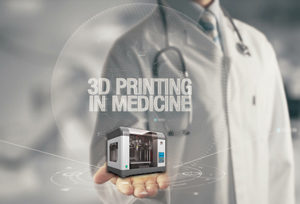A revolution in manufacturing may affect the healthcare supply chain
Did you catch this spring’s announcement that Adidas has partnered with 3D printing firm Carbon to unveil the Futurecraft 4D shoe? The midsoles are crafted with light and oxygen using a 3D printing process called digital light synthesis.
It’s a safe bet that we will see more – and more complex – 3D-printing applications in the consumer world in the years to come.
Already, the technology has affected the development and manufacturing of instrumentation, implants (e.g., cranial plates or hip joints) and external prostheses, such as hands. Some day, 3D printing may be used to create living organs. And when the U.S. Food and Drug Administration issues a draft guidance for the industry on the subject (as it did in May 2016), you know this thing is for real.
It’s too early to tell how 3D printing will affect Journal of Healthcare Contracting readers, but it could change the way in which medical devices are developed, manufactured and acquired.
What it is
3D printing is a process that creates a three-dimensional object by building successive layers of raw material. Each new layer is attached to the previous one until the object is complete. Objects are produced from a digital 3D file, such as a computer-aided design (CAD) drawing or a Magnetic Resonance Image (MRI).
Says the FDA, the flexibility of 3D printing allows designers to make changes easily without the need to set up additional equipment or tools. It also enables manufacturers to create devices matched to a patient’s anatomy (patient-specific devices) or devices with very complex internal structures.
 3D printing can be used to fabricate complex geometric structures, “allowing the creation of engineered porous structures, tortuous internal channels and internal support structures,” something that isn’t possible – certainly not easily – with traditional, injection-mold manufacturing, says the FDA.
3D printing can be used to fabricate complex geometric structures, “allowing the creation of engineered porous structures, tortuous internal channels and internal support structures,” something that isn’t possible – certainly not easily – with traditional, injection-mold manufacturing, says the FDA.
Significantly, the technology speeds up the design process. Rather than going through the much-longer and expensive process of design, prototype, machine tools and finally production, manufacturers can go directly from design to production. That means that manufacturers – and perhaps health systems some day – can design or modify devices to satisfy individual provider’s preferences quickly – far more quickly and far less costly than they could with traditional injection molding.
Want a new handle for that trocar? Coming right up.
Like a jet printer
Here’s how to think about 3D printing, explains Steve Pollack, research scientist, Carbon, Redwood City, California, developer of additive manufacturing processes and materials. Traditional manufacturing calls for the manufacturer to take a chunk of steel or other material and essentially carve away anything that shouldn’t be part of the finished piece or device. “But with additive manufacturing, you start with a liquid or molten solid, maybe even a gas, and only introduce solid material where you want it; and where you don’t want it, you don’t introduce it.”
Pollack knows about the medical world. Prior to joining Carbon in 2015, he was director of the Office of Science and Engineering Laboratories (OSEL), part of the U.S. Food and Drug Administration’s Center for Devices and Radiological Health. His early work experience was with American Hospital Supply, for whom he performed analysis of polymeric materials for such American units as American Edwards and American Bentley.
3D printers essentially operate like ink jet printers, continues Pollack. Whereas the ink printer lays down a set of dots of ink which represent a character, then moves to the next one, the 3D printer solidifies a liquid (or powder) in the X-Y (that is, two-dimensional) plane, then lays down a layer on top of that, and another, and another, until the piece is complete.
The technology dates back to 1984, when Chuck Hull filed his patent for Stereolithography Apparatus (SLA). Two years later, he founded 3D Systems, said to be the first 3D printer company in the world. The company commercialized the first 3D printer – the SLA-1 Stereolithography (SLA) printer – in 1987.
Another pioneer in the field is Scott Crump, founder of Stratasys, who in 1988 invented a process called Fused Deposition Modeling (FDM) by mixing wax and plastic in the family kitchen. 3D printers that run on FDM technology build parts layer-by-layer from the bottom up by heating and extruding thermoplastic filament.
Pollack describes the three basic 3D printing technologies today:
- Stereolithography. Light is shone onto liquid; a chemical reaction solidifies the liquid.
- Powder fusion. Powder is spread in a thin layer, then heated selectively either with a laser or through a chemical “mask” that controls temperature rise, and then solidified.
- Fused Deposition Modeling, sometimes called plastic jet printing, in which a strand of solid polymer is heated to melting and solidified in the desired shape, layer upon layer.
Carbon’s process – Digital Light Synthesis, or DLS – is a variant of the liquid-to-solid, or stereolithography, process, says Pollack. DLS is driven by Carbon’s CLIP technology, which works by projecting light through an oxygen-permeable window into a reservoir of ultraviolet-curable resin. As a sequence of UV images are projected, the part solidifies and the build platform rises. Carbon says the process improves surface quality and creates isotropic mechanical properties (the same in all directions) of the device being printed.
Faster, less expensive
Traditional manufacturing finds designers drawing an object, making a model, showing it to others, then making necessary changes, explains Pollack. At that point, engineering goes back to the drawing board to figure out how to turn this model into something that can be manufactured through injection molding. They have to figure out how to make the “negative” of the shape, so it can be molded in the factory. “Mold engineering is a very tedious, complicated process,” he continues. And it’s expensive. After the mold has been engineered, the team examines the prototype and requests necessary changes, at which point the process starts again.
“But with additive manufacturing, you conceive of the part, print iterations of it until you’re satisfied, then start manufacturing it with the same machine,” says Pollack. By removing the intermediate steps, the manufacturer can release new products in weeks. That means if surgeons request a new handle for a trocar – say, one that is more textured – the manufacturer can conceive and produce it fairly quickly, without spending thousands of dollars (sometimes hundreds of thousands of dollars) creating a mold, then a prototype, then a new mold, etc.
In some medical centers, 3D printing has been used largely for making models, most notably, for preoperative surgical planning, says Pollack. Based on radiographic images, the surgeon prints a model of the patient’s anatomical feature and, in essence, is able to “practice” on the patient before the actual procedure. “We’ve had a lot of requests for that [application], and I suspect we’ll be in that space,” he says.
The challenge for the medical manufacturing community is ensuring that 3D printing can produce devices with: 1) advanced mechanical and physical properties, 2) biocompatibility, and 3) the ability to be sterilized, if necessary.
Sweet spot
Chances are, 3D printing won’t have much of an impact on simple consumables, such as syringes, which can be made economically through traditional injection molding, says Pollack. But it could be used before long to produce new cushion materials for hospital beds, wheelchairs, etc., for the prevention of pressure ulcers.
“Something like a trocar handle, which has internal fluid flow, a camera, complex plumbing, lots of negative space – that’s our sweet spot,” says Pollack. Already the technology has been used by others on an emergency basis to provide upper airways to babies born without one. But producing implants demands long-term testing, animal testing…and regulatory hurdles.
In fact, in May 2016, the FDA issued preliminary recommendations for manufacturers of additive manufactured devices. But the questions remain, Will the agency regulate hospitals as manufacturers of medical devices? And if so, how? “No one knows the answer to that,” says Pollack.


Be the first to comment on "3D Printing"